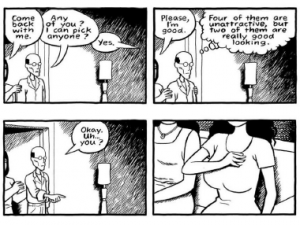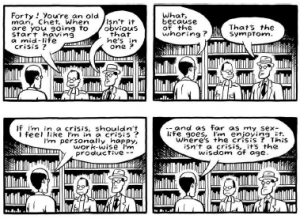A Faceless Anonymity
Jiwani and Young, looking at representations of the Vancouver missing and murdered women in news media representations, identified frames which “entrenched stereotypes about women, Aboriginality, and sex-trade work” (1). Chester Brown’s Paying For It, a memoir of the author’s longstanding status as a john, does something quite different: Brown actually removes these problematic frames of race, class and drug addiction. In fact, he removes almost any frame at all. In an effort to protect the anonymity of the sex trade workers he’s engaged with, Brown works to refrain from “putting in personal details that could potentially reveal their identities” by altering “aspects of their bodies” (vii). He goes even one step further to never illustrate their faces. Tellingly, he expresses that he wishes he “had the freedom to include” information about the sex trade workers’ childhoods, families and relationships as it would have “brought the women to life as full human beings and made this a better book” (vii, italics mine). The resulting text is an incredibly dehumanizing trip through the male gaze and a completely fetishized view of the sex trade.
The male gaze is that “manner of treating women’s bodies as objects to be surveyed, which is associated by feminists with hegemonic masculinity, both in everyday social interaction and in relation to their representation in visual media” (Daniel n.p.). This objectification is unfortunately quite common in representations of women in comics. Certainly, the recent controversy surrounding Milo Manara’s cover for Spiderwoman has brought this tendency to public attention (check out the Hawkeye Initiative to see this practice effectively lampooned). But when Brown refuses to even give his sex trade workers a human face, it only accents the use of their bodies as commodities to be bought and sold.
(pg 73)
The above scene depicts the actual purchase of a woman’s body but, unlike much of the rest of the book’s representations through the male gaze, features fully clothed women (and is thus appropriate for a UBC blog). Furthermore, although Brown has conversations and debates littered throughout Paying For It, he does not move beyond the john’s perspective to consider the experience of sex trade workers.
(pg 124)
Perhaps if there was some sense of satire, there could be some redemptive work done in this text. But for my part I can’t identify any such awareness. Instead, Brown closes Paying For It with several pages of argument for the legalization of prostitution without ever addressing his own problematic representation.
- Brown, Chester. Paying for it: A Comic-Strip Memoir about being a John. New York; Montréal: Drawn & Quarterly, 2011. Print.
- Daniel, Chandler and Rod Munday. “Male Gaze.” The Oxford Dictionary of Media and Communication. Oxford Reference, 2011. Web. 20 Nov. 2014.
- Jiwani, Y., and M. L. Young. “Missing and Murdered Women: Reproducing Marginality in News Discourse.” Canadian Journal of Communication 31.4 (2006): 895-917. Web. 20 Nov. 2014.

